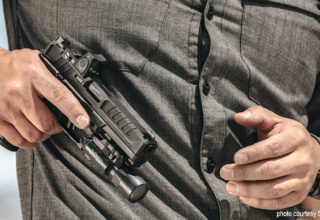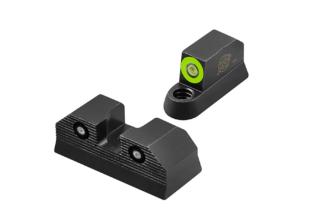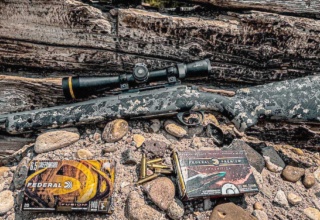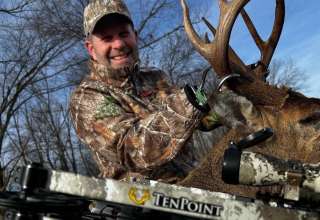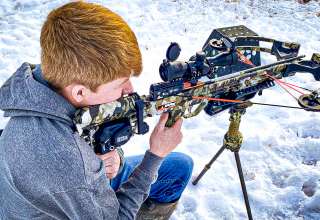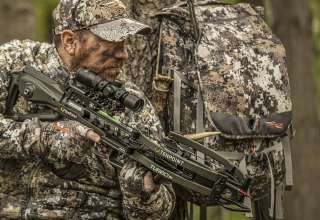Heading West and want to boost your long-range game? Here’s what you need to consider in your bow set-up.
by Jace Bauserman
Born and reared in southeast Colorado, I learned early in my bowhunting career I needed to become proficient at distance. The West is vast and some of its best mule deer, pronghorn, and elk haunts are found in open, lowland terrain.
Am I advocating getting inside 70 yards and letting carbon fly? No! Archery is a close-range game, and over 23 years of hunting the West, my average shot distance on big-game animals is 32 yards. What I am suggesting is lots of long-range practice to make those close-range shots all the easier, and if you find yourself 62 yards from a quartering-away heavy-racked giant, you can settle the pin and deliver a lethal arrow.
The Right Rig
Your bow should choose you, not the other way around. If you and your vertical rig don’t get along, get a different one. It’s that simple. Personally, I like a longer axle-to-axle bow for western hunting. I appreciate the longer platform and stability that platform creates. If you’re in the market, visit your trusted pro shop and spend time shooting some of the new models available.
Projectile Choice
Few things are more critical than the arrow you choose. I like a small-diameter arrow like Easton’s Match Grade 6.5, HyperSpeed Pro, and 5MM Axis. Winds can rock out West, so you want a shaft with less surface area. When it comes to weight, I pull 68 pounds and have a draw-length of 28.75 inches. I prefer a shaft between 7.4- and 9.5-grains per inch and a finished arrow weight between 385 and 410 grains.
Last season, I shot a bull elk at 18 yards (full frontal) with a 383.7-grain HyperSpeed Pro. The shaft was tipped with a 1.5-inch cut SEVR and the lighted nock disappeared into the chest and the head poked out just in front of the right hip. Two weeks later, I shot a pronghorn at 53 yards with the same arrow/broadhead combo and it blew through the buck and buried in the prairie dirt. Some would call this arrow too light, but I like a healthy blend of speed and kinetic energy. I also put a heavy emphasis on front-of-center. My hunting arrows always have an F.O.C. percentage between 11 and 13 percent. Proper F.O.C. helps with both downrange accuracy and penetration.
Sight
Single-pin or multi-pin, it makes zero difference as long as the sight is movable and you’re comfortable with it. Shooting a standard 5-pin sight and trying to estimate holdovers is a recipe for disaster. What about a 7-pin? Yikes! Too many horizontal bars filling the housing.
If you like a clean housing with a single vertical aiming point, go with a sight like TRUGLO’s Range-Rover or Range-Rover Pro. Both come with pre-marked yardage tapes out to 80 yards and the Zero-In adjustment dial makes dialing to the right yardage quick and easy. If you like a multi-pin sight but still want the adjustment, APEX’s Covert 4-Pin is a great choice. The pins are bright and the build is durable. Plus, the sight allows for second- and third-axis adjustment. Sight in at 20, 30, 40 and 50 yards and lock the sight down. Then, use the sight’s bottom pin (50-yard pin) to sight in at further distances. The Covert 4-Pin comes with 120 pre-marked yardage tapes to help simplify setup.
There are benefits to both single- and multi-pin sights. I love a clutter-free housing and single aiming point. With that noted, it can be difficult if you’re dialed-to-the-yard on a 40-yard elk and he closes the distance to 20. A multi-pin moveable allows you to set yardage points and gives you the ability to dial to further distances. Typically, I use a single-pin for pronghorn and mule deer and a multi-pin for elk.
Stabilizer
It’s my opinion too many archers sell themselves short when it comes to stabilizer choice and setup. Screw a six-inch stabilizer into your western hunting bow and all you’re adding is a noise dampening device. You’re getting nothing in terms of stability. Purchase a stabilizer in the 10-inch-and-over range and one that allows you to add and subtract weight. You may also want to experiment with a back bar or a counter-slide system. Personally, I go the front- and back-bar route. My back-bar weights one-ounce more than my front. Experimenting with different stabilizer lengths and weights is essential to downrange accuracy.
The Process
You’ve got your western rig ready. It feels balanced and steady and is holding like a rock in windy conditions. Do me a favor. Don’t jump back to 80 yards and start slinging carbon. This is a recipe for disaster, confidence loss, and target panic.
Before you start sighting in, understand that a moveable-pin sight serves a purpose, and you’re defeating that purpose if you don’t take full advantage of your elevation gang adjustments. I set my moveable sights in a position that allows maximum vertical adjustment along the slide. More vertical adjustment means farther shooting before arrow clearance becomes an issue due to housing obstruction. TRUGLO does a great job with their sight manuals and understanding elevation adjustments is super easy.
Whether you’re shooting a single-pin or multi-pin movable, get your base distances down. With a four-pin multi-pin, you especially want to make sure your 20- and 50-yard pins are set perfectly. This process takes days. Do it too soon and you’ll discover your 20 is hitting a little low or your 50 is hitting a little high. Then you must adjust, which will throw your entire tape off. I spend a solid week shooting at 20- to 50-yards before starting my tape build. I recommend shooting dots as well as 3-D targets.
When sighting in a single-pin, I use the same process. I shoot both dots and 3-D targets and spend no less than a week dialing distances between 20 and 50 yards. Once dialed at 20 and 50, I match those marks up to the provided sight tapes, find the right one and put it on. That doesn’t guarantee perfection out to the furthest distance set on the tape. You may have to go through several tapes to find the right one.
Remember, archery is a close-range game, but learning to shoot consistent groups at distances like 70-, 80-, 90- and even 100-yards builds close-range confidence.








